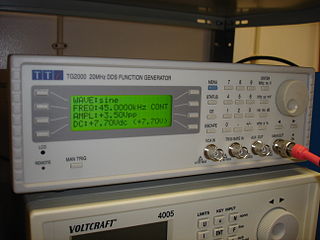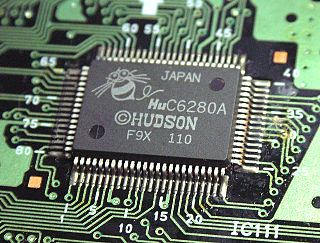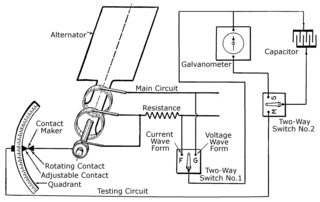In electronics and telecommunications, modulation is the process of varying one or more properties of a periodic waveform, called the carrier signal, with a separate signal called the modulation signal that typically contains information to be transmitted. For example, the modulation signal might be an audio signal representing sound from a microphone, a video signal representing moving images from a video camera, or a digital signal representing a sequence of binary digits, a bitstream from a computer.
A signal generator is one of a class of electronic devices that generates electrical signals with set properties of amplitude, frequency, and wave shape. These generated signals are used as a stimulus for electronic measurements, typically used in designing, testing, troubleshooting, and repairing electronic or electroacoustic devices, though it often has artistic uses as well.

In electronics, acoustics, and related fields, the waveform of a signal is the shape of its graph as a function of time, independent of its time and magnitude scales and of any displacement in time. Periodic waveforms are those that vary periodically – they repeat regularly at consistent intervals.

The Intel MCS-51 is a single chip microcontroller (MCU) series developed by Intel in 1980 for use in embedded systems. The architect of the Intel MCS-51 instruction set was John H. Wharton. Intel's original versions were popular in the 1980s and early 1990s, and enhanced binary compatible derivatives remain popular today. It is a complex instruction set computer, but also has some of the features of RISC architectures, such as a large register set and register windows, and has separate memory spaces for program instructions and data.

In signal processing, sampling is the reduction of a continuous-time signal to a discrete-time signal. A common example is the conversion of a sound wave to a sequence of "samples". A sample is a value of the signal at a point in time and/or space; this definition differs from the term's usage in statistics, which refers to a set of such values.

The MOS Technology 6581/8580 SID is the built-in programmable sound generator chip of the Commodore CBM-II, Commodore 64, Commodore 128, and MAX Machine home computers.
A numerically controlled oscillator (NCO) is a digital signal generator which creates a synchronous, discrete-time, discrete-valued representation of a waveform, usually sinusoidal. NCOs are often used in conjunction with a digital-to-analog converter (DAC) at the output to create a direct digital synthesizer (DDS).

The SN76489 Digital Complex Sound Generator (DCSG) is a TTL-compatible programmable sound generator chip from Texas Instruments. Its main application was the generation of music and sound effects in game consoles, arcade games and home computers, competing with the similar General Instrument AY-3-8910.

A voltage-controlled oscillator (VCO) is an electronic oscillator whose oscillation frequency is controlled by a voltage input. The applied input voltage determines the instantaneous oscillation frequency. Consequently, a VCO can be used for frequency modulation (FM) or phase modulation (PM) by applying a modulating signal to the control input. A VCO is also an integral part of a phase-locked loop. VCOs are used in synthesizers to generate a waveform whose pitch can be adjusted by a voltage determined by a musical keyboard or other input.

Direct digital synthesis (DDS) is a method employed by frequency synthesizers used for creating arbitrary waveforms from a single, fixed-frequency reference clock. DDS is used in applications such as signal generation, local oscillators in communication systems, function generators, mixers, modulators, sound synthesizers and as part of a digital phase-locked loop.

In electrical engineering, a function generator is usually a piece of electronic test equipment or software used to generate different types of electrical waveforms over a wide range of frequencies. Some of the most common waveforms produced by the function generator are the sine wave, square wave, triangular wave and sawtooth shapes. These waveforms can be either repetitive or single-shot. Another feature included on many function generators is the ability to add a DC offset. Integrated circuits used to generate waveforms may also be described as function generator ICs.

The HuC6280 8-bit microprocessor is Japanese company Hudson Soft's improved version of the WDC 65C02 CPU, an upgraded CMOS version of the popular NMOS-based MOS Technology 6502 8-bit CPU, manufactured for Hudson by Seiko Epson and NEC. The most notable product using the HuC6280 is NEC's TurboGrafx-16 video game console.

An arbitrary waveform generator (AWG) is a piece of electronic test equipment used to generate electrical waveforms. These waveforms can be either repetitive or single-shot in which case some kind of triggering source is required. The resulting waveforms can be injected into a device under test and analyzed as they progress through it, confirming the proper operation of the device or pinpointing a fault in it.
In computing, a waveform buffer is a technique for digital synthesis of repeating waveforms. It is common in PC sound cards.
A Bitcrusher is an audio effect that produces distortion by reducing of the resolution or bandwidth of digital audio data. The resulting quantization noise may produce a "warmer" sound impression, or a harsh one, depending on the amount of reduction.
A digital pattern generator is a piece of electronic test equipment or software used to generate digital electronic stimuli. Digital electronics stimuli are a specific kind of electrical waveform varying between two conventional voltages that correspond to two logic states. The main purpose of a digital pattern generator is to stimulate the inputs of a digital electronic device. For that reason, the voltage levels generated by a digital pattern generator are often compatible with digital electronics I/O standards – TTL, LVTTL, LVCMOS and LVDS, for instance.

The history of the oscilloscope was fundamental to science because an oscilloscope is a device for viewing waveform oscillations, as of electrical voltage or current, in order to measure frequency and other wave characteristics. This was important in developing electromagnetic theory. The first recordings of waveforms were with a galvanometer coupled to a mechanical drawing system dating from the second decade of the 19th century. The modern day digital oscilloscope is a consequence of multiple generations of development of the oscillograph, cathode-ray tubes, analog oscilloscopes, and digital electronics.

The W65C816S is a 16-bit microprocessor (MPU) developed and sold by the Western Design Center (WDC). Introduced in 1983, the W65C816S is an enhanced version of the WDC 65C02 8-bit MPU, itself a CMOS enhancement of the venerable MOS Technology 6502 NMOS MPU. The 65C816 is the CPU for the Apple IIGS and, in modified form, the Super Nintendo Entertainment System.

A digital storage oscilloscope (DSO) is an oscilloscope which stores and analyses the input signal digitally rather than using analog techniques. It is now the most common type of oscilloscope in use because of the advanced trigger, storage, display and measurement features which it typically provides.
The OPL series are a family of sound chips developed by Yamaha. The OPL series are low-cost sound chips providing FM synthesis for use in computing, music and video game applications.











